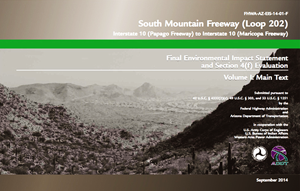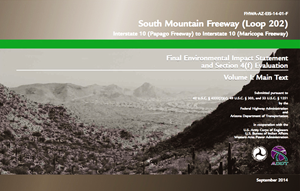
ADOT conducts field investigations at sites with cultural, historic significance
(Editor’s note: News releases are published unedited, unless they contain factual errors.)
PHOENIX – Along the 22-mile corridor where the South Mountain Freeway will be built over the next few years, archaeologists are working to gather and recover items and information from the past that may have cultural or historic significance.
At one point along the freeway footprint, archaeologists are systematically digging 5-foot-deep trenches looking for signs that ancient people lived or farmed there. At other sites, archaeologists have found pottery pieces and 19th- century shotgun shells, among other items, and also documented historic petroglyphs.
The Arizona Department of Transportation is completing this and other work at 16 various sites that have been identified as potentially having cultural or historic significance during the 13-year study phase of the South Mountain Freeway. As a result of these extensive studies, ADOT published an environmental impact statement allowing decision-makers to better understand the potential positive and negative impacts of the project on the environment.
Whether they contain evidence of those who inhabited this area in prehistoric times, artifacts from farms important to the area’s heritage or even an abandoned railroad, these sites must be managed according to federal and state historic preservation laws before freeway construction begins this summer.
Since the start of the study phase in 2001, ADOT and the Federal Highway Administration have been carrying out cultural resource studies and consulting tribal leaders, tribal historic preservation officers, state historic preservation offices, land managers and other stakeholders.
“Protecting and preserving cultural resources is the law, but it’s also the right and respectful thing to do,” said Linda Davis, who leads ADOT’s Historic Preservation Team.
By law, some of this work must remain confidential while it is happening, and sometimes a site will be fenced and monitored by security for safety reasons and to protect what ADOT’s research and field surveys suggest may be found there.
Federal and state regulations require ADOT and the Federal Highway Administration to identify and address any potential environmental impacts that could affect cultural or historic resources, air and water quality, wildlife, noise levels, hazardous waste and more before proceeding with any construction project.
This makes the agency one of the largest sponsors of archaeological research in Arizona. As part of its environmental planning process, the agency considers the effects of transportation projects on sensitive cultural resources by consulting with Native American communities, conducting research and limiting impacts from highway construction as much as possible.
When a site is determined to have historic or cultural significance, ADOT’s Historic Preservation Team develops a plan, in consultation with tribal leaders, tribal historic preservation officers, state historic preservation offices, land managers and other stakeholders to minimize harm from construction. At a site where construction will occur, archaeologists will gather items and information, a process referred to as data recovery.
Work at prehistoric and historic sites may include thorough documentation or excavation and extraction, analysis and preservation of artifacts, which can include sending the identified artifacts to an accredited repository, such as the Arizona State Museum, Museum of Northern Arizona, Pueblo Grande Museum or Huhugam Heritage Center. Historic structures are also documented.
“Building any transportation facility has consequences, including cultural and environmental impacts that ADOT is committed to minimizing as much as possible,” ADOT Director John Halikowski said. “In fulfilling its environmental commitments, including how it handles cultural resources, ADOT has to strike a balance between the need for a modern transportation network and protecting Arizona’s cultural heritage.”
The South Mountain Freeway, which will run east and west along Pecos Road and then north and south near 59th Avenue, connecting with Interstate 10 on each end, is expected to open by late 2019. The freeway will provide a long- planned direct link between the East Valley and West Valley and a much-needed alternative to Interstate 10 through downtown Phoenix. Approved twice by Maricopa County voters, the South Mountain Freeway will complete the metropolitan area loop freeway system.
Construction is scheduled to begin in summer 2016. Preliminary engineering, including geotechnical and utility work, and property acquisition and preparation, have been underway since spring 2015 after ADOT received final federal clearance to move forward.
For more information, visit azdot.gov/SouthMountainFreeway.
More housing markets on the upswing
Freddie Mac Wednesday released its Multi-Indicator Market Index® showing the spring home buying season off to a strong start across many parts of the country. Also, six more metro areas and one more state, Kentucky, are now within their benchmark ranges.
The national MiMi value stands at 83.8, indicating a housing market that’s on the outer range of its historic benchmark level of housing activity, with a +1.00 percent improvement from February to March and a three-month improvement of +1.56 percent. On a year-over-year basis, the national MiMi value has improved +7.23 percent. Since its all-time low in October 2010, the national MiMi has rebounded 41 percent, but remains significantly off from its high of 121.7.
News Facts:
Thirty-six of the 50 states plus the District of Columbia have MiMi values within range of their benchmark averages, with the District of Columbia (102), Hawaii (96.7), Colorado (95.9), Montana (95.6) and Utah (95.6) ranking in the top five.
Sixty-five of the 100 metro areas have MiMi values within range with Salt Lake City, UT (98.9), Honolulu, HI (98.7), Los Angeles, CA (98.2), Nashville, TN (98.1) and Austin, TX (102.2) ranking in the top five.
The most improving states month over month were Tennessee (+2.49%), Mississippi (+1.97%), Oregon (+1.93%) Florida (+1.74%) and Massachusetts (+1.64%). On a year-over-year basis, the most improving states were Colorado (+15.54%), Florida (+15.19%), Oregon (+14.17%), New Jersey (+13.70%), and Nevada (+13.64%).
The most improving metro areas month over month were Chattanooga, TN (+3.15%), Nashville, TN (+2.72%), Oxnard, CA (+2.51%), Knoxville, TN (+2.32%) and Orlando, FL (+2.23%). On a year-over-year basis, the most improving metro areas were Orlando, FL (+19.54%), Denver, CO (+18.22%), Tampa, FL (+17.02%), Cape Coral, FL (+16.89%), and Portland, OR (+15.63).
In March, 41 of the 50 states and 84 of the top 100 metros were showing an improving three-month trend. The same time last year, 45 of the 50 states, and 96 of the top 100 metro areas were showing an improving three-month trend.
Quote attributable to Freddie Mac Deputy Chief Economist Len Kiefer:
“The U.S. housing market is poised to have its best year in a decade and the spring home buying season is off to a strong start. Pent up demand for homes and near record-low mortgage rates are bolstering housing markets across the country. The National MiMi currently stands at 83.8, the highest since September of 2008. Home purchase applications are up nearly 14 percent from one year ago, mortgage delinquencies continue to trend down, and robust employment growth are all positive signs. The National MiMi payment-to-income indicator is also up 4 percent from the same time last year. The impact of rising house prices coupled with tight supplies of for-sale homes in many markets has the potential to make it difficult for the typical family to buy a home despite these low mortgage rates.
“Similar to last month, we still see pockets of weakness in the Midwest and South, though they are improving, while the Northeast, and especially the West are generally doing better. It’s also worth noting that North Dakota dropped out of the top 5 ranked states in MiMi for the first time since the index was launched in 2014.”












